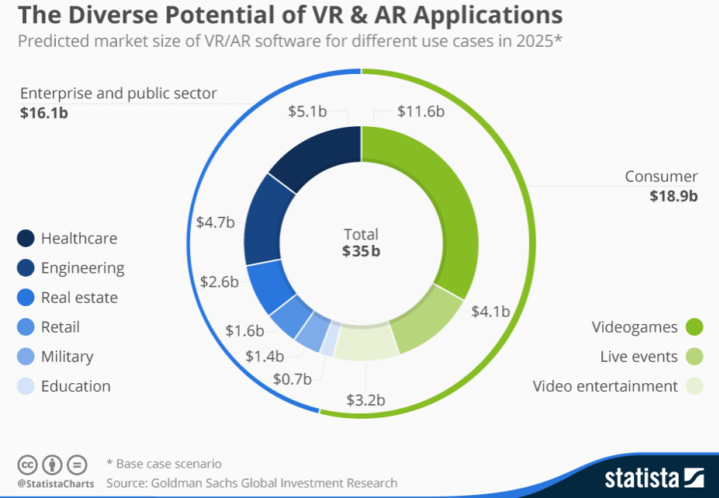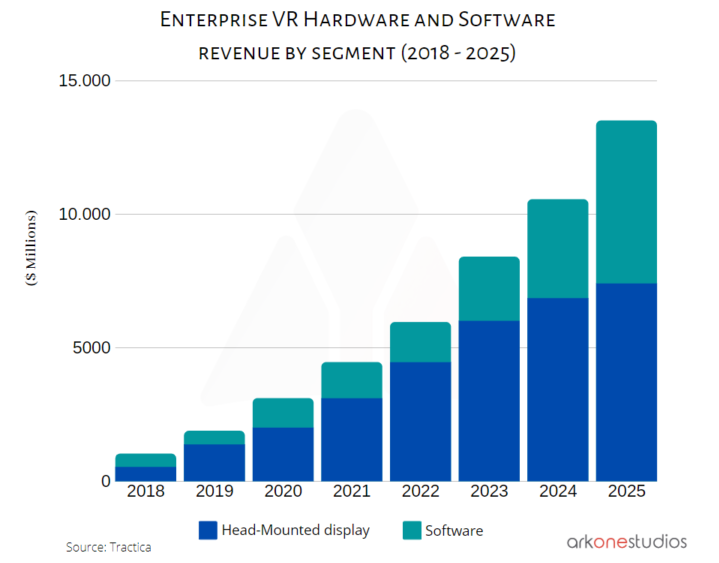How big will the VR industry become?
Anyone who has ever experienced Virtual Reality knows that, even though the technology might not be suited for everyone, its huge potential has yet to be unleashed. Thanks to its extremely immersive nature, VR is a medium that allows us to experience extraordinary and vivid emotions like no other. But, is that all there is to it? What can we expect from it in the near future?
More than an entertainment device
Let’s clarify something first. Virtual Reality might be an amazing way to experience some thrills… Most of us have enjoyed VR firsthand and if you haven’t… Well, let’s just say there are some serious experiences out there worth checking out. The video game industry has already offered some great games that rely on this technology and the near future seems even more promising.

Taking AR also into account, these are the very diverse Goldman Sachs G.I. R. predictions for both technologies, as reflected by Statista.
But VR potential and appeal should not only be reduced to entertainment. It’s safe to assume that it might seriously revolutionize the way we learn and educate in the following years. Not to mention that its impact might eventually extend to the way we socialize or do business.
[smartslider3 slider=3]
Thousands of technology companies around the world are already investing time, money and effort into developing software or even hardware that might just take the world by storm. If you explore Steam or Oculus libraries, for instance, you’ll be surprised by how much interesting educational content you can already find there. And tons of the content is free!
There has been no massive adoption for now but a huge business opportunity lies ahead

VR hardware offering includes the Playstation based, offering, PC-based software, Movile VR, Cardbox VR.
VR specialized headsets (Tier 1) are averaging U$S 400 dollars, both for PCs and consoles if we take into account Playstation’s offer. And that’s without including the hardware to run the software, meaning a powerful pc with a great GPU or a powerful PS4 Pro. Standalone VR headsets or less powerful hardware (Tier 2) such as Oculus Quest, cost U$S 400 and are becoming increasingly popular with a great margin for growth, but its hardware has some limitations.

VR software sales are yet to grow exponentially to hardware, but it is coming.
Diverse surveys point out that almost half of those who are familiar with VR want to adopt the technology but find it too expensive at the moment. Forty percent of the remaining say there aren’t games or experiences appealing enough to invest yet.
A bright future ahead
The numbers are promising, right? We have seen this before. As technology advances year by year, upgrading performances and reducing costs, it is safe to estimate that adopters will bloom. There is also an increasing number of developers who are now orientating their efforts towards providing specific software that succeeds in offering appealing experiences, both narrative and gameplay-wise. This can only become a virtuous cycle. As new adopters shall increase the appeal to develop VR experiences, more and better software will increase the number of people that decide to invest and become a VR adopter. And so on.
Though we haven’t seen AAA games and full-fledged support until recently, Sony has been investing time and effort in this for a while now and has made it clear that its PS5 will soon be compatible with the PSVR headset. At the same time, Valve’s Half Life series has just launched and received global praise. Half-Life: Alyx seems to be Steam owner’s way of telling everyone else: this is the way.

Head-Mounted Displays are not cheap peripherals yet we seem to have reached an attractive market and software is coming.
It is safe to assume VR is here to stay and will only grow. Just as Tractica forecasts, we estimate that in the next couple of years software will outpace hardware’s growth, both in revenue and in sales. Only time will tell.


